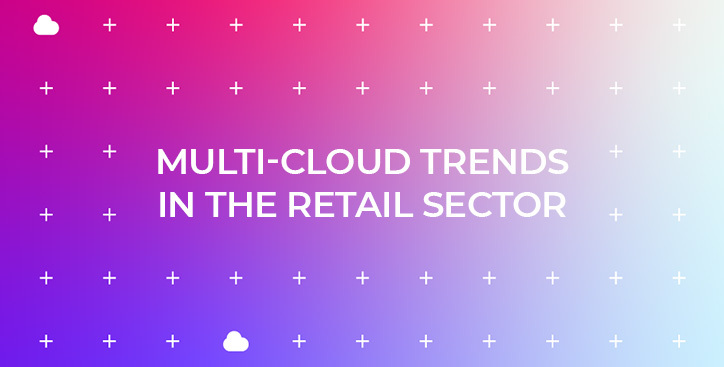Multi-cloud trends in the retail sector
By Alex Hawkes|12 September, 2022

In retail, the cloud changes everything because it offers flexibility and the opportunity to do things better, or to do things that were previously impossible, for a lower cost. This is especially true in a multi-cloud and hybrid cloud environment, where retailers can connect their legacy private data centres with public clouds to enhance their offering and make it more competitive.
Over the last couple of years, millions of consumers have adopted and increased their online shopping habits, and retailers have followed suit, shifting to a digital-first retail strategy.
It now looks like those behaviours are here to stay, and in a post pandemic world personalisation and omnichannel retail roll-out have accelerated significantly, powered by cloud adoption and further driven by supply chain volatility.
Cloud adoption in retail
Research from consulting and business process services company Wipro, in February 2022, found that the retail industry is now leading in cloud adoption. More than three quarters (78%) of retailers, and 71% of CPG (Consumer Packaged Goods) brands are either mature or advancing intermediate users of cloud, compared to 68% across all other industries.
Furthermore, rapid cloud adoption is paying off for retailers and CPG brands, with retailers registering revenue gains of 4.75%, the highest seen in any sector from cloud investments, according to Wipro.
One of the key factors here is the improvements and agility that can be delivered by the cloud, either to digital channels directly, or to compliment physical channels with digital benefits - a concept known as hybrid shopping.
According to a study carried out by the IBM Institute for Business Value and the National Retail Federation in early 2022, hybrid shopping is on the rise and retailers must become more agile to meet customers where they are, integrating digital and in-store experiences.
Emrabing multi-cloud
In an increasingly competitive space, both for online retail and bricks and mortar, businesses need to use all the advanced technologies at their disposal and cloud computing offers the promise of simplified workflows, reduced IT costs, and an improved customer experience.
Some of the benefits retailers aim to capitalise on by adopting the cloud, include:
- Enhanced online shopping: Championed by the likes of Amazon, the retail industry produces a lot of data on consumer behaviour, which can be used to tailor the online shopping experience, with personalisations and recommendations, even going so far as to predict buying behaviour.
- Price management: Price is a major, if not the major, factor affecting consumer buying behaviour. Cloud-based applications help sellers keep track of competitors’ prices, analyse sales trends and discount performance, and feed data sets that can be leveraged to set competitive prices both in physical stores and online. Advances in AI and Machine Learning also mean much of this process can be automated.
- Inventory management: Managing and monitoring inventory is one of the most challenging tasks in retail and further chinks in the industry’s armour have been revealed during the recent supply chain crisis. Inventory management has traditionally been a very manual process, but cloud services can provide and compute real-time data, and integrate with other technologies such as IoT implementations for supply chain optimisation, or warehouse management applications. Several of the leading cloud providers, including Microsoft Azure and AWS offer retail industry specific cloud frameworks, designed to address some of these challenges.
- Disaster recovery: With high consumer engagement and a general awareness that shoppers can get something in exchange for their information, data in the retail industry is a valuable asset. But large retailers with operations in multiple geographies may find themselves with data bound by sovereign boundaries, creating a sprawl across regions and increasing the vector for system failure. But public cloud maturity, including connectivity, means data can be backed up and disaster recovery initiated from anywhere at any time.
Yet while the cloud offers many benefits, having a sole cloud service provider is increasingly outweighed by the risks of an infrastructure with the potential for vendor lock-in, or a single point of failure.
This is why, for reasons of operational resiliency, best-of-breed infrastructure, or meeting regulatory requirements, retailers are expanding their cloud adoption to multi-cloud strategies that can support new retail models.
Retail cloud connectivity
A multi-cloud strategy however, puts new requirements on the network that connects all these assets together. This is where a Network-as-a-Service (NaaS) platform adds real value to a multi-cloud environment.
We have another blog, here, that dives into greater detail about choosing the right multi-cloud connectivity solution.
But typical NaaS benefits include:
● An agile network infrastructure that can adapt to traffic changes from cloud adoption
● Migration of applications to the cloud with confidence in the network’s ability to match
● Offload technical risk and maintenance to the provider and focus on core business
Using Console Connect, businesses in the retail sector can reduce network complexity and enhance their network performance when accessing the cloud.
Through a user-friendly portal, organisations can meet their multi-cloud connectivity needs in a matter of minutes - and create a more secure path to the cloud that avoids the public internet and delivers a more reliable and consistent network performance for those important applications and services, ensuring your retail operation stays up during those high-traffic, high-revenue periods.

.jpg)





.jpg)
